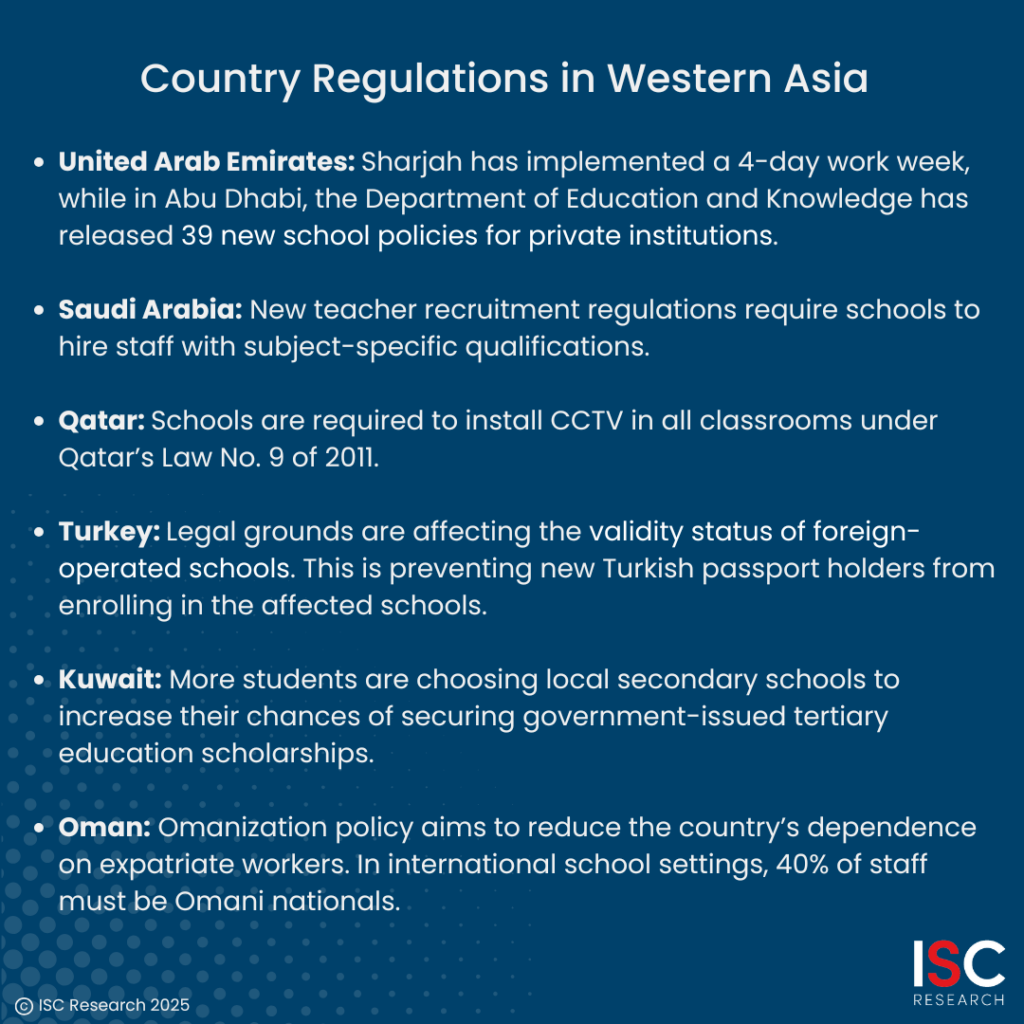Western Asia is the world-leading subregion by international school numbers, student enrolment, and market-generated income. The numbers currently stand at 2,311 international schools, 2.14 billion students, and a total annual fee income of $16.6 billion USD, making it a prime export destination for education suppliers.
However, expanding a business into this area is a complex journey. This actionable guide draws on insights from Samina Yasmin of OxEd and Assessment, and from Sami Yosef and William Saville of ISC Research, as shared during our recent masterclass webinar. It outlines the key steps for education suppliers aiming to enter and succeed in Western Asia’s international school market.
Step 1: Understand education market growth trends in Western Asia
The education landscape is fast-paced and ever-changing; staying updating on emerging trends and regulations is essential for developing a tailored approach to specific markets. As documented in our Market Intelligence Reports, ISC Research has identified the key regional developments driving Western Asia’s industry-leading growth:
- Government investments and policy shifts
Governments across the region are aiming to transform society, diversify their economies, and position their countries as global leaders in development and innovation. In Saudi Arabia, the government-launched Saudi Vision 2030 initiative aims to reduce economic dependence on oil, lower the rate of unemployment, and invest in key sectors such as healthcare and education. This is leading to the integration of new technologies in classrooms, as well as increased private sector participation in education to enhance overall school quality. Similarly, Qatar National Vision 2030 has driven the launch of the Ministry of Education and Higher Education‘s 2024-2030 Strategy, which aims to ensure equitable access to learning opportunities, foster continuous professional development for teachers, and incorporate the latest pedagogical practices into learning environments.
- Rising expatriate populations
The Middle East has emerged as a global business hub, attracting multinational corporations, entrepreneurs, and investors. In the United Arab Emirates, approximately 88% of the total population consists of foreign nationals , for whom private schools are the default option due to restricted access to local public education. In Kuwait, expatriates constitute approximately 70% of the country’s population, and 40% of the total in Saudi Arabia. As demand grows for globally recognised curricula, English–language instruction, and clear pathways to universities worldwide, ISC Research has identified 57 new international schools set to open across Western Asia to serve its highly multicultural communities.
- Household prosperity
Many families in the Middle East have experienced an increase in disposable income, largely resulting from the economic diversification initiatives and new employment opportunities. Qatar’s GDP per capita is approximately $80,000 USD, compared to $49,000 in the UAE and a global average of $13,000 USD. This allows families to dedicate a larger portion of their budget to high quality education and to consider premium tuition-fee options.
Step 2: Adapt business strategies to regional and local needs
Education suppliers need to align their products and operational strategies with region-specific considerations. For instance, Ramadan takes place in the 9th month of the Islamic calendar and typically means reduced working hours in many professions. When scheduling meetings or product demonstrations, cultural and religious events such as this need to be respected. Additionally, any product-related content and materials should reflect recent curricula updates to align with national education standards. Across countries like Qatar, Saudi Arabia, and the UAE, this includes compulsory Arabic language and Islamic education.
Beyond this, suppliers must account for country-specific regulations depending on their chosen market:

Step 3: Build strong relationships with key stakeholders
In Western Asia, successful business relies heavily on trust and personal conversations. Rather than adopting a hard-sell approach, negotiations tend to unfold gradually – grounded in patience, consistent follow-ups, and genuine relationship-building. As such, it’s often more effective to open conversations with insights into emerging market trends or relevant research, as the emphasis here is on thoughtful exchanges rather than immediate product promotion.
While relationship-building favours in-person interactions, suppliers without a local presence in the region can still engage with key decision-makers through LinkedIn, Facebook, and WhatsApp. These platforms host specialised groups focused on specific market niches, where international educators actively exchange insights and best practices. Additionally, communication tools like Zoom and Slack should be used to facilitate virtual face-to-face meetings where in-person options aren’t feasible, as this format continues to be an essential step in building trust.
Step 4: Drive sales in Western Asia’s international school market
Once the foundational relationship with the stakeholder is established, a crucial step remains: driving the sale in an engaging way that demonstrates a deep understanding of both the market and the individual school. To do so, consider the following strategies:
- Research school needs and decision-making structures
Conduct detailed research on the institution’s unique challenges, culture, and hierarchical structure. Note that schools within larger international groups often maintain consistent operational frameworks across their network. Additionally, understand the decision-maker’s background, whether they are local or expatriate, for instance, to tailor your approach.
- Showcase partnerships with accrediting bodies
When presenting your solutions, highlight any relevant connections to bodies such as British Schools in the Middle East, British Schools Overseas, Cognia, and Council of International Schools – there are a total of 830 accredited schools in Western Asia, 75% of which are affiliated with these organisations. This helps to establish early rapport with the stakeholder and showcases your reputable presence within the sector.
- Demonstrate measurable impact
Present case studies and usage reports, clearly illustrating key metrics such as how much administrative time your product saves – a particularly relevant benefit in Sharjah, UAE due to the reduced weekly working hours. Trial periods are also highly valued in Western Asia, as they reduce the perceived risks involved with implementing a new service.
- Emphasise long-term value
Position your offer as an ongoing partnership, not just a product. Schools are looking for long-term solutions and will expect immediate support should the need arise. Without a regional presence, implement alternative systems that provide real-time assistance to reinforce your commitment.
Looking to expand your business internationally? Book a free consultation with our team.



